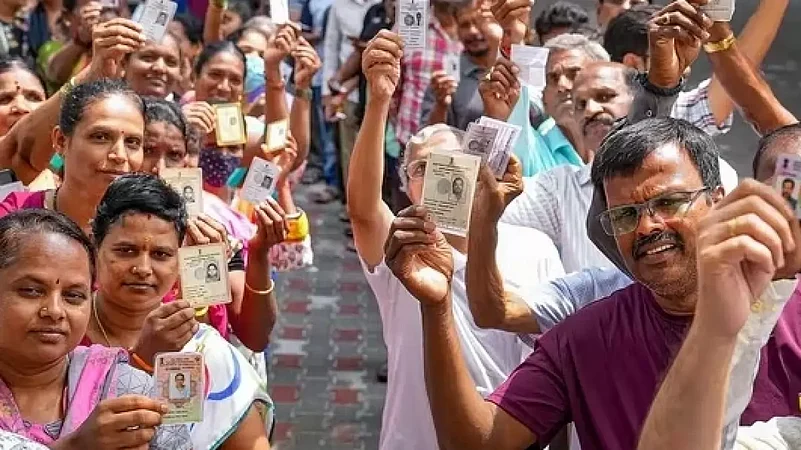I met Roshan, a Bajrang Dal loyalist and a fitness trainer, at a gym in Mangalore on April 13. Initially, he was shy and reluctant to talk.
“Why? Are you not confident that your party will retain power?” I asked.
“Yes, yes. We will win,” Roshan responded. He got more nervous when he had to face the camera and give a sound byte. “The BJP will certainly win because the government was good.” After a pause, he said: “The government has fought a good fight against Covid.” He then smiled awkwardly at me which implied, “That’s enough, right”.
When I asked him to comment on the incident in 2022 wherein 24 people died at a hospital in Mysuru allegedly due to the deficiency of oxygen, Roshan responded with silence, as if he had not heard me at all.
Not just Roshan, many “BJP loyalists” whom I met on the streets of Coastal Karnataka during the election coverage were not willing to go on record and comment. They, however, chatted freely off the record. Despite Coastal Karnataka being the strong hold of the BJP, the supporters of the ruling party were reluctant to say it on camera that their party is going to win. On the other hand, there were those who did not hesitate to express their anger, frustration and disillusionment.
“Forty per cent,” said Sathish, the taxi driver who took me to the villages of Mangalore, while talking about corruption. “Here we have to pay a 40 per cent commission for everything.”
While Ignatius, a truck driver, was worried about diesel and petrol prices, Abdul Khader, a Mangalore-based auto driver was worried about the escalating prices of the essential commodities and cooking gas. Navin, another auto driver, simply did not want to talk politics, which according to him, is “messed up” and has made the “lives of ordinary people hell.”
The Muslim traders and businessmen whom I met in South Kannada were concerned about the safety and security of the minorities. Iqbal, who runs a furniture shop in Mangalore, was concerned that the eclipse of secularism has made the existence of other religious communities difficult.
As a journalist, the most challenging part of political reporting, especially in the context of elections, is dealing with the resentful detachment and cynicism expressed by the people. It takes a lot to make people talk responsibly and at the same time feel the pulse of their emotions, ranging from anger, sorrow, contempt, or staunch loyalty to some party.
While interacting with people to understand how the government as well as the opposition has fared, helps us gain valuable insights and is also a great leaning exercise, but making people talk with a sense of rationality is a tedious task. ‘Playing devil’s advocate’ may or may not work. People then easily go into a defence mode, which clouds their rational and logical thinking.
Which tool is then the best so that a reporter is able to dig deeper into the minds of the people? Well, it’s listening, listening, and listening. However, it’s not as simple as it appears to be. You must keep your rationality aside and set up a completely different framework of rationality.
My experience of talking to people whom I had met at Raja Rajeswari temple at Polali village in Bantwal constituency over and again reminded me of this theory. It was the day of the temple festival. Under the scorching sun, hundreds of people were following the procession chanting prayers in a trans. The Congress candidate and former minister Ramanath Rai, who had ‘burned his fingers’ in the last election by projecting his secular image, was present at the temple and was busy meeting devotees. Interestingly, Rai lost the last election after he said in a public speech ‘I could win six times due to the grace of Allah’ in a public speech. This though was only a triggering factor to the otherwise fragile electoral status of the Congress.
What would then be the ‘right question’ to ask to people in such a situation? Despite having two decades of experience in reporting, I often grapple with such situations.
“The BJP is the best party. I am happy with the performance of the government,” said Anandan, a daily wage worker and a devotee who was waiting for the procession.
“Are you not unhappy about price hike of essential commodities like oil and cooking gas?” I asked.
While asking the question, I knew that this might not be the right question in that context because the question was framed with my rational thinking which was entirely different than that of Anandans.
“I am happy with the government. No government can make everyone happy, right?” He asked me in return. I agreed. Yes, no government can make everyone happy. It is the universal truth.
Every time I go for election reporting, I return to the office with a sense of self-reflection. Rather than getting an answer to the most binary question of who is going to win and who is not going to win, I return with a bunch of questions that are not amenable to my rational thinking.
I realised that I have still not mastered the skills to understand how the right wing in India has successfully mobilised emotions in politics.
In his book Politics, Ethics and Emotions in ‘New India’, Ajay Gudavarthy, political theorist and Associate Professor at JNU, attempts to explain the underbelly of politics and political mobilisation by the right wing. According to him, “without making sense of emotions, understanding of the Right merely through ideological frames is insufficient”.
For the time being, I find answers in Gudavarthy’s writing. A paragraph from his book reads: “Hindutva is a strange animal, quasi-real and quasi-manufactured. Part of it is optics and part of it is organic. At one level, it connects the social and the political, and at another level, it disconnects the political from the social. It is partially based on fear, intimidation, and violence, while partially it represents a growing social consent. It is both concrete and abstract, it is imagined, hysterical, and delusional and therefore unverifiable, but it also speaks to the everyday experiences and instituted ‘lay morality.”





















